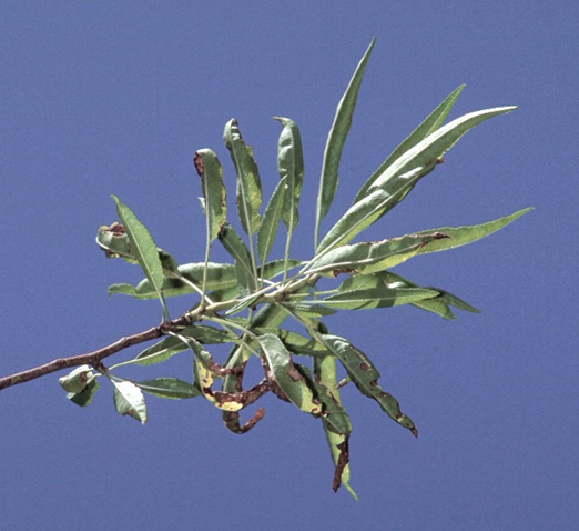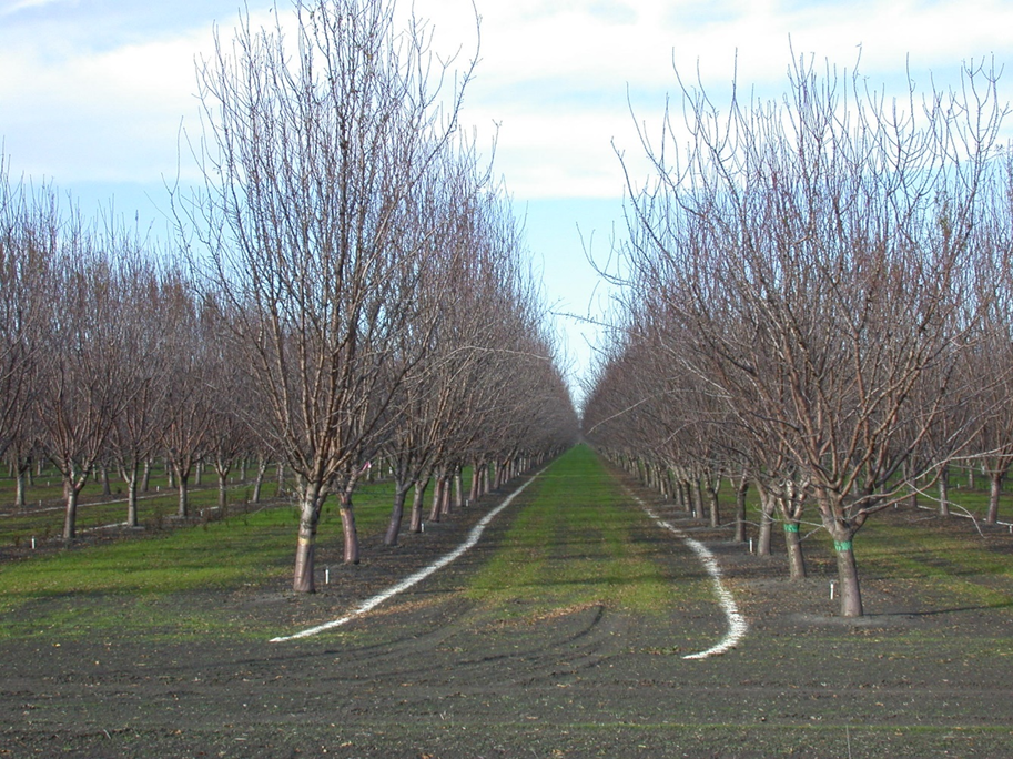Katherine Jarvis-Shean, UCCE Orchard Advisor, Sacramento, Solano and Yolo Counties
Joseph Connell, UCCE Farm Advisor Emeritus, Butte County
Patrick H. Brown, UC Davis Professor of Plant Sciences
Adequate potassium is critical to sustained yields in an almond orchard. There are many approaches to providing almond trees with the potassium they need, depending on your local climate conditions, orchard infrastructure and budget.
Why does potassium matter?
Potassium (K) is important for helping plants move and store energy, regulate water loss, grow, flower and fruit. Almonds are particularly K hungry crops. UC Davis and UCCE research found that inadequate potassium decreased yields by increasing spur death and the percent of spurs that had flowers, and thus set nuts.
Following a heavy cropping year, spur survival was 11% lower in potassium-deficient trees (decreasing from 59% to 48%). Of bearing spurs that survived, fruiting spurs decreased from 48% to 40% (the rest produced leaves but not flowers). If spurs had been vegetative the year before, 86% of the spurs on the high potassium trees set fruit, whereas only 75% set fruit in the low potassium trees. The lower spur survival may be related to decreased spur carbohydrate levels. Measurements in the same trial found whole-tree leaf light interception and per-leaf photosynthesis was lower in the low K trees.
All this adds up to the fact that low K will have a carry-over impact on orchard yield. Low K decreases yields the following year by decreasing the number of flowering (and thus fruiting) spurs where the tree will set nuts. Trees which received no potassium in a heavy crop year (4,040 lbs/ac across all treatments) yielded 15% lower the following year, compared with trees which received adequate potassium.
How much potassium do almond trees need?
Research by the Brown lab at UC Davis found 80 lbs of K are exported for every 1,000 kernel lbs of almonds harvested, including the hulls, shells and kernels. 45-61% of this K accumulated in the fruit in the first three months (86 days) after full bloom.
How can you know if trees are getting enough potassium?
Visual Symptoms. If trees are deficient enough in potassium to show leaf symptoms, tree health and yield are already being impacted. While it’s better to rely on leaf analysis to manage potassium, it’s still good to know the visual symptoms of inadequate K. Potassium deficient almond trees show leaf symptoms in the spring if the deficiency is severe but by early summer even milder deficiencies can produce symptoms on heavily cropped trees. If soils are very wet and cold, when first leafing out, potassium deficient trees appear pale in color and have small leaves with little new growth. Once new shoots are growing in April and May, pale, potassium deficient leaves roll into a boat shape and develop tip and marginal scorching. This classic symptom is seen in the tree tops on leaves in the middle of new shoot growth.

Figure 1. Once new shoots are growing in April and May, pale, potassium deficient leaves roll into a boat shape and develop tip and marginal scorching (photo: UC IPM).
Leaf analysis. Because potassium deficiency can have a significant impact on yield before symptoms of deficiency are visible, leaf analysis is an important tool for monitoring tree potassium status. Leaf samples collected in July are useful for evaluating K levels since leaf tissue levels are relatively stable at that time of year. Klevels above 1.4% are considered adequate. UC research was unable to show any yield benefit of pushing leaf potassium much above this adequate level. Some research suggests that too much potassium interferes with uptake and use of calcium and magnesium. However, keeping trees a little above 1.4% may make sense. Leaf analysis results are an average of all sampled trees, so if results land squarely at the 1.4% adequate level that means some trees are above that level and some are below. Overshooting 1.4% will ensure that more trees are above the adequate threshold. Higher than adequate levels will also help provide “back-up” for heavy set years, which may be especially important to sprinkler irrigated orchards where in-season fertigation to meet higher than usual potassium needs is not effective.
What’s the Best Source of Potassium?
Potassium can be applied to the soil, be injected into a drip irrigation system (fertigation) or be applied through foliar sprays. Which approach is “best” for a particular orchard will depend on the soil, rainfall, irrigation system, existing potassium and chloride levels, and budget. Potassium ions (K+) are readily adsorbed to the negatively charged clay particles in the soil, which then makes them only slowly available to the tree. In soils rich in vermiculite clays, fixation can be rapid and nearly irreversible. Because of this, soil-applied potassium is often concentrated in a band, to overwhelm the potassium-adsorbing capacity of the soil in that small strip. In-season fertigation manages this fixation by concentrating potassium in the wetting zone of a micro- or drip irrigation system. Foliar sprays circumvent this fixation problem by cutting out the soil “middle man” and applying the potassium directly to the tree.
Given enough potassium, and enough water in the right place to move it into the soil, the source rarely makes a difference in yield, according to UC research in the southern San Joaquin Valley and earlier UC work at the Nickels Soils Lab at Arbuckle. Common forms of potassium fertilizer are potassium sulfate (K2SO4, “SOP”), potassium chloride (KCl), potassium thiosulfate (KTS) and potassium nitrate. In the San Joaquin Valley, a Brown Lab trial compared winter banded SOP, winter SOP plus in-season (fertigated) KTS, and in-season KCl. When application rates were 30-80% higher than demand, potassium source did not impact yields. In the Nickels trial, winter banded SOP, in-season SOP, in-season MKP (mono-potassium sulfate) and in-season KTS were compared. At Nickels, banded SOP in a single-line drip irrigated orchard increased leaf K significantly less than other potassium sources.
If you’re confused by the nomenclature, blame Medieval Latin! You might be asking, “If the symbol for potassium is K, where’s the K in SOP?” SOP is short for “sulfate of potash”. Before potassium was mined, it was leached out of burnt plant matter. As far back as early medieval times, ashes were soaked in a pot, and then the water was boiled down to concentrate what we now know was leached potassium, for use in a variety of processes, like soap making and textile bleaching. Hence, “pot-ash”. The symbol K comes from kalium, the Latin word for plant ash, which itself was derived from al-qalyah, which is Arabic for “plant ashes”.
Many growers combine multiple approaches to meet their tree’s potassium needs, for example supplying some potassium through fall banding and supplementing with in-season drip fertigation.
Fall Banded Soil Applications. Historically, banding SOP has been the standard practice on much of the almond acreage in the Sacramento Valley. The relatively high rainfall and more common heavy soils (which don’t leach K) in this region makes this a viable practice. With the widespread adoption of micro-irrigation systems and the increased productivity of almond orchards, growers are increasingly adopting more frequent and more targeted K practices. Banding is still well suited to full coverage irrigation systems in which direct fertigation of K is ineffective.
SOP is the most commonly used soil-applied source of potassium. KCl has also been used for soil applications and if chloride (Cl) can be leached on deep well drained soils to prevent Cl buildup, it can meet K needs. Because of the need for rainfall or sprinkler irrigation to move banded SOP or KCl into the soil, the fall banding approach may not be efficient in lower rainfall zones, and certainly is unlikely to be appropriate for much of the San Joaquin Valley. In drip and micro- irrigated orchards, banded potassium outside the wetted root zone, misses the target and is unlikely to be fully available.
In-Season Fertigation. Injecting K through in-season drip irrigation is also very effective because the amount of K per wetted area is very high, potassium fixation is minimized and potassium penetrates into the most active root zone of the tree. There are numerous sources of potassium that are injectable, including KTS, high purity, finely ground SOP, KCl and potassium nitrate. Drip irrigation is a very efficient potassium delivery system. Injecting through micro-irrigation can also be effective when wetted area is concentrated.
Spring foliar applications. Potassium deficiency can also be corrected by foliar sprays through the growing season when sufficient material is applied. Potassium nitrate and KTS are common sources. Other sources include potassium carbonate and many foliar blends. While this approach is a direct and efficient means of K delivery, foliar K is more expensive than soil applied K. In addition, only a small portion of a season’s potassium needs, 5-10 lbs K, can be taken up by the leaves per application. Thus, foliar sprays are most suited to augment an existing potassium management program, particularly in a year with a heavy set.



Leave a Reply